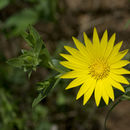Comments
provided by eFloras
The polymorphic
Xanthisma texanum has always been kept distinct from other genera in the tribe, in part due to the unique involucre, here considered a derived structure. The relationship to members of
Machaeranthera in the broad sense was never considered until DNA data became available. According to J. C. Semple (1974), the following combination of features characterizes the species: "heterocarpic fruit with a pappus of bristly scales only, fruit pubescence of long white ascending hairs, receptacle slightly convex with a persistent reticulate network of subulate scales." Interestingly, all of these characters are found in at least some of the taxa of the newly expanded genus.
J. C. Semple (1974) classified varieties texanum and orientale under the typical subspecies (as they are peripherally sympatric and appear to hybridize) and the allopatric X. texanum var. drummondii at the subspecific level. The three taxa are here treated as varieties.
- license
- cc-by-nc-sa-3.0
- copyright
- Missouri Botanical Garden, 4344 Shaw Boulevard, St. Louis, MO, 63110 USA
Description
provided by eFloras
Annuals, rarely biennials; taproots 2–10+ cm. Stems 1–3, usually branched in distal 1 / 2 , sometimes throughout, moderately stout to stout, not wiry, mostly glabrous. Leaves: basal (if persisting) 50–80 × 15–25 mm, pinnatifid, rarely 2-pinnatifid; cauline evenly spaced, proximal often spatulate, distal 2 / 3 narrowly to broadly lanceolate, 5–35 × 8–12 mm, markedly reduced distally, margins of proximal pinnatifid to coarsely serrate, of distal minutely, evenly serrulate or entire and antrorsely ciliolate, teeth or cilia 50–90+ per side, teeth tipped by white seta 0.1–1.5 mm, faces glabrous. Peduncles moderately to densely hispidulous, eglandular; usually ebracteate. Involucres hemispheric, 5–10 × 11–20 mm. Phyllaries in 3–4 series, faces glabrous; outer usually 1.5–8.5 × 2–5 mm, ciliate; inner 2–10.5 × 1.5–4 mm, often ciliate. Ray florets 12–34; corollas yellow, tubes 2.5–3 mm, laminae 5–18 × 2–3 mm. Disc florets 50–200+; corollas 4.5–5 mm. Cypselae 1.6–1.8 mm; pappi 5–6.5 mm, outer lengths often 0.5 longest.
- license
- cc-by-nc-sa-3.0
- copyright
- Missouri Botanical Garden, 4344 Shaw Boulevard, St. Louis, MO, 63110 USA
Xanthisma texanum: Brief Summary
provided by wikipedia EN
Xanthisma texanum, the Texas sleepydaisy or star-of-Texas, is an ornamental plant native to the United States. This plant is usually propagated by seeds.
- license
- cc-by-sa-3.0
- copyright
- Wikipedia authors and editors

